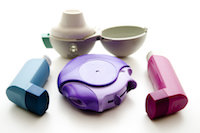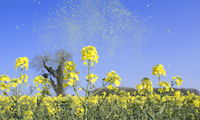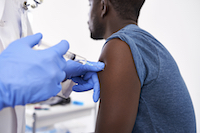Causes of bronchial asthma and definition of the disease
Bronchial asthma is a disease characterized by chronic inflammation of the airways, respiratory symptoms (wheezing, shortness of breath, chest congestion, and cough) that vary in time and intensity and occur along with variable airway obstruction.
5 Ways for Better Asthma Control
Airway obstruction in asthma
Bronchial asthma leads the population in prevalence. According to the latest statistics, the United States and Europe have recorded a doubling in the number of people affected by this pathology over the past 20 years.
According to the estimates of the World Health Organization, about 248 million people suffer from bronchial asthma, and by 2025 an increase to 400 million people around the world is predicted.
Studies have also found an increase in the global incidence in children aged 5-8 years to 12%, and among adolescents 12-15 years to 14%.
The emergence and development of bronchial asthma is influenced by a number of reasons, among which are household allergens, working conditions, genetic causes, and other factors.
Household allergens
Household dust, animal hair, feathers in pillows, and household chemicals can influence the development of bronchial asthma. Among the most studied allergens that cause bronchial asthma are house dust mites. They are found in dust and products with woven material or padding, such as mattresses, pillows, stuffed toys and bedding. Studies have shown that exposure to dust mites in early childhood is an important factor in the development of asthma: 18 out of 20 children with asthma were found to be allergic to them. In addition, the higher the level of dust mite exposure in children as young as one year old, the earlier the first asthma attack occurred. The relative risk of developing bronchial asthma in people exposed to high levels of this allergen has been shown to increase fivefold.
Working conditions
According to epidemiological studies, the proportion of bronchial asthma resulting from exposure to unfavorable factors of the work environment ranges from 2% to 15%. There are many substances that lead to the development of occupational asthma. Among them: phthalates, aldehydes, isocyanates, metals, grain and flour dust, fluxes, epichlorohydrin, formaldehyde, animal allergens, resins and wood dust, adhesives, latex.
List of occupations that most often develop occupational asthma:
- Welders
- Painters
- Medical workers
- Construction workers
- Poultry and livestock workers
- Food and chemical workers
- Hairdressers
- Bakers and confectioners
- Woodworkers
Genetic causes
The development of bronchial asthma depends on the interaction of various genes and environmental factors. Genes affecting the disease include genes for T-lymphocyte types 1 and 2 (Th1 and Th2), immunoglobulin E (IgE), interleukins, granulocyte monocyte colony-stimulating factor (GM-CSF), tumor necrosis factor-alpha (TNF-α), as well as the ADAM33 gene, which regulates cytokine production and is responsible for stimulation of airway smooth muscle and fibroblast division.
Other predisposing factors include:
- Gender (boys are more likely to get the disease in early childhood and girls after age 12)
- Excess weight
- Pollen, fungal, viral and bacterial allergens
- Respiratory tract infections
Bronchial asthma symptoms
Characteristic symptoms of bronchial asthma:
- Cough and heaviness in the chest
- Wheezing breath
- Expiratory shortness of breath
Signs of bronchial asthma vary in severity, frequency of occurrence, and depend on contact with various allergens and other triggers. They also depend on the antiasthmatic treatment chosen, the number and severity of concomitant diseases. Most often the symptoms disturb at night or in the early morning hours, as well as after physical effort, which leads to a decrease in physical activity of patients. Inflammatory changes in the bronchial tree and airway hyperresponsiveness act as the main pathophysiological signs of asthma.
Mechanisms causing the main symptoms of bronchial asthma:
| Symptom | Mechanism |
|---|---|
| Cough | Irritation bronchial receptors, Contraction of the smooth bronchial musculature |
| Wheezing Breathing | Bronchoobstruction |
| Congestion chest | Constriction shallow airways, Air traps |
| Dyspnea | Stimulated breathing |
| Nocturnal symptoms | Inflammatory process, Bronchial hyperresponsiveness |
Pathogenesis of bronchial asthma
The pathogenesis of bronchial asthma can be visualized in the form of a diagram:
Classification and stages of bronchial asthma
Today there are a huge number of classifications of asthma. Below are the main ones, they help in understanding the causes and are necessary for statistics. In addition, a modern approach in dealing with asthma is given, as distinguishing asthma phenotypes.
The following classification of bronchial asthma is used in the United States:
| 1 | Asthma with a predominant allergic component | Allergic exogenous Atopic Allergic bronchitis without further clarification Allergic rhinitis with asthma Hay fever with asthma |
| 2 | Non-allergic asthma | Idiosyncratic Endogenous nonallergic |
| 3 | Asthma combined | Association with conditions mentioned 1,2 |
| 4 | Unspecified asthma | Asthma of late onset Asthma bronchitis without further clarification |
| 5 | Asthmatic status | Acute, severe asthma |
At the moment priority is given to personalized medicine, which at the moment has no possibility to create individual medication and ways of examination or prevention of disease development for a particular patient, but it is proposed to single out certain categories. These subgroups of patients are called phenotypes, characterized by peculiarities in the causes, development, examination methods and therapy.
Currently, there are the following phenotypic forms:
- Allergic bronchial asthma. This type is not difficult to diagnose – the debut of the disease falls on childhood, is associated with a history of allergies. As a rule, relatives also have respiratory or skin manifestations of allergies. Immune inflammation in the bronchial tree has been documented in people with this variant. Treatment of patients with this type of asthma with local corticosteroids (GCS) is effective.
- Non-allergic bronchial asthma. This type of bronchial asthma is mostly affected by adults, with no history of allergic pathology and no allergy-related heredity. The character of inflammatory changes in bronchi of this category can be neutrophilic-eosinophilic, low-granulocytic or combine these forms. Inhaled glucocorticosteroids do not work well in treating this type of pathology.
- Asthma with permanent airway constriction. There is a group of patients in whom irreversible changes in the bronchi begin, usually people with uncontrollable symptoms. Changes in the bronchial tree are characterized by rearrangement of the bronchial wall. Therapy of these patients is complex and requires close attention.
- Asthma with delayed onset. Most patients, mostly female, have asthma in their solid years. These categories of patients require higher concentrations of glucosteroids or become almost resistant to basic therapy.
- Asthma combined with overweight. This type accounts for the fact that the overweight and asthma category suffers more severe attacks of choking and coughing, there is constant shortness of breath, and changes in the bronchi are characterized by moderate allergic inflammation. Treatment of these patients begins with correction of endocrinological abnormalities and diet therapy.
Complications of bronchial asthma
If the diagnosis of bronchial asthma is not made in time and the therapy to control the course of the disease is not selected, the following complications can develop:
- Pulmonary emphysema and pneumosclerosis, respiratory failure
- Pulmonary atelectasis
- Pulmonary heart failure, up to and including acute heart failure
- Interstitial, subcutaneous emphysema
- Spontaneous pneumothorax
- Endocrine disorders
- Neurological disorders
Diagnosis of bronchial asthma
Bronchial asthma is a clinical diagnosis, which is established by the doctor, taking into account the complaints, anamnestic features of the patient, functional diagnostic methods taking into account the degree of reversibility of bronchial obstruction, special examination for allergopathology and differential diagnosis with other diseases with similar complaints. The debut of the disease usually occurs at the age of 6 years, less often after 12 years. But occurrence is also possible at a later age. Patients complain of episodes of difficulty in breathing at night, in the wee hours of the morning, or associate the complaints with emotional, and sometimes physical overload. These symptoms are combined with difficulty breathing, with abnormal exhalation, wheezing sounds in the chest, and recurrent cough with small amounts of sputum. These symptoms can be managed on their own or with the use of bronchodilators. It is necessary to relate the appearance of signs of pathology after interaction with allergenic substances, seasonality of symptoms, association with clinical signs of rhinitis, presence of atopic diseases or asthmatic problems in the history.
If a diagnosis of asthma is suspected, questions should be asked:
- Are you bothered by wheezing sounds in your lungs?
- Do you cough at night?
- How do you tolerate physical exertion?
- Do you experience chest tightness, coughing after being in a dusty room, coming in contact with pet hairs, or during spring and summer?
- Have you noticed that you are often sick for more than two weeks, and the illness is often accompanied by coughing and shortness of breath?
Specific methods of diagnosis
1. Evaluation of lung function and degree of bronchial constriction. Spirometry is a basic and simple method of investigating the severity and recurrence of bronchial obstruction and is also used to further evaluate the course of bronchial asthma. When carrying out FVD it is possible to identify the type of changes in bronchial breathing (obstructive, restrictive, mixed), to assess the severity of the condition. For accurate diagnosis of bronchial constriction recurrence, a test with bronchodilators can be applied. The generally accepted positive test is an increase in BEF1≥12%. The following types of bronchodilators are used: fast-acting β2-agonists (salbutamol, fenoterol, terbutaline) with response control within 14 minutes. A positive test indicates the reversibility of impairment values in bronchial asthma.
Peak flowmetry.
Measurement of peak expiratory flow rate with a special simple apparatus – peak flow meter – is often used. It is necessary to explain to the patients how to measure PSV in the morning hours (before the use of drugs); in this case we measure the lowest PSV value. The measurement of PSV should also be made in the late evening; this will be the highest PSV level. Variability during the day PSV is called PSV amplitude. The recording of PSV should be done for about 2-3 weeks. This study assesses PSV in home and work environments, which allows you to determine how external environment factors (allergens, occupational factors, physical strain, stress, and other triggers) affect the patient’s well-being.
Determination of bronchial hyperresponsiveness. The presence of bronchial hyperresponsiveness is considered an important criterion for the diagnosis of asthma. The most used method of bronchial hyperresponsiveness testing at the moment is the bronchoconstrictor test with biologically active substances (methacholine, histamine), as well as physical exercise. Evaluation of the study parameters is assessed by changes in OEF1. If OEF1 decreases by more than 22% (from the initial figures), the test can be considered positive.
2. Allergy testing. Refers to allergy testing on the skin, provocateur tests with certain types of allergens, and laboratory testing to detect specific IgE antibodies. Skin tests are the most common, since they are easy to perform, reliably accurate, and safe for patients.
Allergy tests on the skin
1. There are the following types of skin allergy tests by technique:
- Scarification allergy tests
- Prick-test
- Intradermal samples
- Allergy testing
To perform skin tests, you must have a history of the patient, showing an unambiguous connection between the complaints and contact with the allergen or group of allergens in the pathogenesis of the disease, IgE-dependent type of allergic reaction.
Skin testing is not performed in cases of:
- Exacerbation of an allergic disease
- Acute viral or bacterial diseases (acute respiratory infections, nasopharyngitis, bronchitis, etc.)
- Severe asthma, its uncontrolled course
exacerbation of infectious diseases (tuberculosis, syphilis, etc.) - Decompensated phase of diseases in other organs and systems (cardiovascular, endocrine, digestive, urinary or circulatory system)
- Autoimmune diseases (SLE, rheumatoid arthritis, scleroderma, etc.)
- The presence of tumors
- Mental illnesses
- Pregnancy and lactation
2. Provocative inhalation test. Respiratory Society of America experts recommend this test. Spirometry is performed before the test, and if the SPH1 does not fall below 75% of normal, the patient is allowed to undergo provocation. A nebulizer is used, which can be used to dispense certain doses of allergen by jetting, and the patient makes several inhalations with certain dilutions of the allergen under the constant supervision of an allergologist. After each inhalation, the results are evaluated after 15 minutes. The test is considered positive when SPH1 decreases by 25% or more from the initial values.
3. Laboratory diagnostic methods. Laboratory diagnosis is a non-essential method. It is performed if another test is necessary to confirm the diagnosis. The main indications for prescribing laboratory diagnosis are:
- Age under 3 years of age
- A history of severe allergic reactions to skin examination
- The underlying disease is severe, with virtually no periods of remission
- Differential diagnosis between IgE-mediated and non-IgE-mediated allergic reactions
- Exacerbation of skin diseases or skin conditions
- Continuous use of antihistamines and glucocorticosteroids is required
- Polyvalent allergy
- False results are obtained when skin testing is performed
- Refusal of the patient to undergo skin testing
- Skin test results do not match clinical findings
Laboratories use the following methods of determining total and specific IgE – radioisotope, chemiluminescence, and enzyme immunoassays.
The newest approach to diagnosing allergic diseases at the moment is molecular allergy testing.
It helps to diagnose more accurately, to calculate the prognosis of the course of the disease. For diagnosis, it is important to consider the following nuances:
The difference between true sensitization and cross reactions in patients with polyallergies (when there is a wide spectrum of sensitization)
reduction of the risk of severe systemic reactions during allergy testing, which improves patient adherence
accurate identification of allergen subtypes for allergen-specific immunotherapy
Immuna Solid phase Allergen Chip (ISAC) technology is the most common. It is the most comprehensive platform that includes more than 100 allergenic molecules in a single study.
Treatment of bronchial asthma
Unfortunately, modern medicine cannot cure a patient of bronchial asthma, but all efforts are limited to creating a therapy that preserves the patient’s quality of life. Ideally, in controlled asthma, there should be no symptoms of the disease, spirometry values should remain normal, and there should be no signs of pathological changes in the lower lungs.
Conservative methods of treatment
Pharmacotherapy for asthma can be divided into 2 groups:
- Drugs of situational use
- Drugs for continuous use
Drugs for seizure management are as follows:
- Short-acting β-adrenomimetics
- Anticholinergic drugs
- Combination drugs
- Theophylline
Drugs for maintenance therapy of bronchial asthma include:
- Inhaled and systemic glucocorticosteroids
- Combinations of long-acting β2-agonists and glucosteroids
- Long-acting theophylline drugs
- antileukotrienic agents
- Antibodies to immunoglobulin E
For the treatment of bronchial asthma, both the drugs and the way these substances are administered to the body and airways are important. Drugs can be administered orally per os, parenterally, and inhaled.
The following groups of drug delivery through the respiratory tract are distinguished:
- Aerosol inhalers
- Powder inhalers
- Nebulizers
European guidelines on asthma treatment
The European guidelines propose a stepped approach to the treatment of bronchial asthma. The choice of step depends on the severity of the symptoms. An increase in severity in the absence of control or at high risk of exacerbations is a step up.
Visit Fr-Pharma24.com for information about medical products and services.
Decrease to a step no earlier than after three months of stable asthma control. Reduction should be very gradual – every three months, reduce the dose of inhaled glucocorticosteroids (IGCS) by no more than 50%.
Monotherapy with short-acting β2-agonists (QDBAs), according to the new guidelines, is not recommended even for symptom management because of the high risk of exacerbations and death.
For adult patients over 18 years of age, baseline and maintenance therapy with budesonide or formoterol is recommended.
For patients over 12 years of age, a fixed combination of salbutamol and beclamethasone dipropionate.
In children from 2 years of age – baseline monotherapy with antileukotriene drugs, up to 5 years – iHCS, preferably via nebulizer.
In the second stage, low-dose inhalers plus DDBA daily are used. Treatment with low-dose inhaled corticosteroids (ICS) avoids exacerbations, improves quality of life, and reduces the severity of symptoms.
In adults, the starting dose of beclamethasone dipropionate is 400 mcg, in children 200 mcg. Children receiving more than 400 mcg iHCS should be monitored by their pediatrician.
Antileukotriene medications, as an adjunct to glucosteroids, are used in the presence of airway hypersensitivity, virus-dependent asthma, and allergic rhinitis.
When long-acting β2-agonists (DDBAs) are contraindicated, tiotropium bromide should be added to the inhalers. It is also added to the combination of glucosteroids and DDBA when exacerbations are frequent or severe.
When high-dose inhaled glucocorticosteroids are prescribed, all patients, especially children, should be seen by a specialist in severe bronchial asthma.
Omalizumab, mepolizumab, reslizumab, benralizumab, dupilamab are prescribed to improve quality of life, reduce the severity of symptoms and frequency of exacerbations. Prescribing of drugs and selection of dosage is performed by a doctor.
In bronchial asthma, special breathing exercises are used, which do not reduce inflammation. Gymnastics consists of a series of exercises aimed at muscle relaxation and reduction of breathing frequency, which should become smooth and slow, without deep and frequent breaths.
Thus, according to the new recommendations, one should:
Do not use monotherapy with short-acting β2-agonists (QDBAs);
for children and adults, taking inhaled glucocorticosteroids for mild asthma reduces symptoms and exacerbations.
Coronavirus infection and bronchial asthma
Because of the new coronavirus infection, it is recommended that the use of spirography (a method of assessing lung health by measuring the volume and velocity of exhaled air) be reduced if possible and that treatment with nebulizers be reduced, replacing them with spacers with a mask. Compared to a nebulizer, a spacer is easier to use, more compact, and more effective.
Folk methods of treatment
The effectiveness and safety of folk methods for the treatment of bronchial asthma is not proven. It is important to know that the preparations of nontraditional medicine are not clinically and pharmacologically tested, so they can have a high allergenicity, which is especially dangerous in bronchial asthma.
Prognosis. Prevention
In the current setting, there is no evidence that environmental, climatic, and nutritional factors may worsen the course of the disease, and eliminating these triggers will help reduce the severity of the disease and reduce the amount of pharmacotherapy. Further clinical observations in this regard are required.
Primary prevention is distinguished. It includes:
- elimination of allergens during pregnancy and in the first years of life of the
- child (hypoallergenic household and hypoallergenic diet);
- breastfeeding;
- infant formula;
- food supplements during pregnancy (there are several hypotheses of the protective effect of fish oil, selenium, vitamin E);
- quitting smoking during pregnancy.
Secondary prevention includes:
- Avoiding pollutants (increased concentrations of ozone, ozone oxides, particulate matter, acid aerosols)
- Control of house dust mites
- Not having pets
- Not smoking in the family





